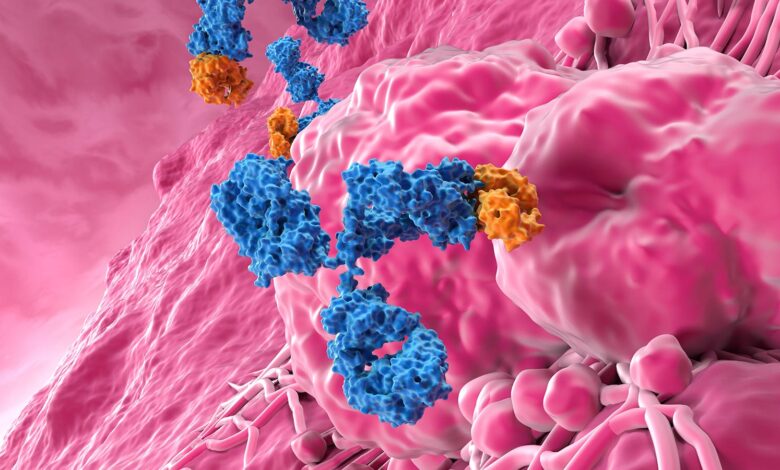Precision Medicine Approach Shows Promise for Anaplastic Thyroid Cancer

—
Median OS as high as 43 months with mutation-guided targeted agents plus immunotherapy
by
Charles Bankhead, Senior Editor, MedPage Today
October 25, 2024
Two prospective trials of immunotherapy in thyroid cancer, one of them negative, provided support for precision-medicine approaches that include immunotherapy.
A trial of atezolizumab (Tecentriq) and mutation-selected targeted agents led to better overall survival (OS) as compared with historical results in anaplastic thyroid carcinoma (ATC), reaching a maximum of 43 months in BRAF-mutant tumors. On the other hand, dual immunotherapy with nivolumab (Opdivo) and ipilimumab (Yervoy) did not meet the prespecified response rate in a mixed cohort of patients with aggressive thyroid cancers, but showed some promise in ATC.
The studies were reported simultaneously in JAMA Oncology. The author of an accompanying editorial emphasized that “further triage and enhancement of therapies must rely on sensitive biomarkers.”
“Promising results are emerging for immunotherapy in treating patients with anaplastic thyroid carcinoma,” wrote Alfred King-yin Lam, MBBS, MD, PhD, of Griffith University School of Medicine and Dentistry in Southport, Australia. “Combining multiple treatment modalities, including immunotherapy, is expected to improve for patients with this aggressive cancer. Timely use of predictive biomarkers, application of new technology, and clinical trials are pressing needs that will help clinicians provide better healthcare to patients with aggressive thyroid cancer, in particular anaplastic thyroid carcinoma.”
With a historical median OS of 5 months, ATC has one of the highest mortalities among all cancers, noted Maria E. Cabanillas, MD, of the University of Texas MD Anderson Cancer Center in Houston, and colleagues in the introduction to the ATC study. Reasons for the poor prognosis include rapid growth in the neck that compromises respiratory function and swallowing, delayed diagnosis, high rate of inoperable status, high rate of metastasis, and advanced age of many patients at diagnosis.
ATC is derived from different subtypes of differentiated thyroid cancers, which have distinct driver mutations, the authors continued. Among the mutations, only the BRAF V600E variant has proven to be actionable. The FDA approved the dabrafenib/trametinib (Tafinlar/Mekinist) combination in 2018 for BRAF V600E-mutated ATC.
Clinical trials of single-agent targeted drugs have shown limited efficacy. In the only trial of single-agent immunotherapy for ATC, the investigational PD-1 inhibitor spartalizumab led to a response rate of 19% and median OS of 5.9 months.
Cabanillas and colleagues hypothesized that the combination of a PD-1/L1 inhibitor and targeted therapy would improve OS in ATC. To test the hypothesis, they enrolled patients with unresectable ATC into a phase II trial with three parallel cohorts assigned to biomarker-based treatment. Patients with BRAF V600E-mutated cancer received atezolizumab plus vemurafenib (Zelboraf) and cobimetinib (Cotellic). Those with RAS or NF1/2-mutated tumors received atezolizumab plus cobimetinib. Patients without those variants received atezolizumab and the VEGF inhibitor bevacizumab (Avastin).
The primary outcome was median OS for the entire cohort as compared with the historical median of 5 months. Primary data analysis included 43 patients, 19 with the BRAF variant, 21 with a RAS-NF1/2 variant, and three with none of the variants.
Median OS for 42 evaluable patients was 19 months. Median OS and progression-free survival (PFS) for the individual cohorts were 43 and 13.9 months for the BRAF V600E group, 8.7 and 4.8 months for the RAS-defined group, and 6.21 and 1.3 months for the bevacizumab cohort.
“The genetically matched targeted therapy plus immunotherapy combination strategy across [all cohorts] resulted in an OS of 19 months — to our knowledge the longest OS reported to date in an ATC clinical trial, achieving the primary objective of this study,” the authors stated.
“Responses and OS were particularly promising in cohort 1 with vemurafenib plus cobimetinib combined with atezolizumab in BRAF V60oE-mutated tumors, resulting in an ORR [objective response rate] of 50%, median PFS of 13.93 months, and median OS of 43.24 months,” they continued. “This study was designed prior to the FDA approval of a similar BRAF/MEK inhibitor combination, dabrafenib/trametinib, which resulted in an ORR of 56%, median PFS of 6.7 months, and median overall survival of 14.5 months.”
“Although it is not possible to directly compare these studies, our findings exceeded the survival with dabrafenib/trametinib in BRAF-mutant ATC by more than 2 years. It should be noted that in our study, the ORR was lower than expected because two patients underwent surgical resection of the primary tumor and were considered unconfirmed PRs [partial responses].”
The findings from the trial likely reflect a cohort of patients with ATC treated in clinical practice, as enrollment allowed for patients who could not swallow and received targeted therapy in suspension or crushed and added to food. The dabrafenib/trametinib trial that supported FDA approval excluded patients who could not swallow, the authors noted. Additionally, the spartalizumab trial required ECOG performance status 0-1, whereas the current trial allowed enrollment of patients with 0-2 performance status.
The mixed-cohort trial of patients with advanced thyroid cancers, reported by Kartik Sehgal, MD, of Dana-Farber Cancer Institute in Boston, and colleagues, included 51 patients, with 49 evaluable for analysis. The study population comprised 34 patients with radioiodine-refractory differentiated thyroid tumors (RAIR DTC), 10 with ATC, and seven with medullary thyroid cancer (MTC).
All patients received nivolumab every 2 weeks and ipilimumab every 6 weeks until disease progression. The primary endpoint was ORR in the RAIR DTC cohort (32 of 34 evaluable). The trial had statistical power to conclude the ORR was >10% and to detect an ORR of 25%. Analyses of the ATC and MTC cohorts were exploratory.
The primary analysis showed an ORR of 9.4% in the RAIR DTC cohort, consisting of partial responses in two of six patients with oncocytic subtype and one of five with poorly differentiated thyroid cancer subtype. An additional 17 (53.1%) patients had stable disease, resulting in a clinical benefit rate (CBR) of 62.5%.
The exploratory analyses showed partial responses in three (30%) patients with ATC and none of the patients with MTC. Two patients with ATC had stable disease (CBR 50%) as did two in the MTC cohort (CBR 28.6%).
OS and PFS were secondary endpoints. Median PFS in the DTC group was 7.1 months, and after a median follow-up of 24 months, median OS was 24.6 months. The ATC cohort had a median PFS of 4.3 months, and median OS had yet to be reached after a median follow-up of 22.2 months. The MTC cohort had a median follow-up of 24 months, median PFS of 2.1 months, and median OS not yet reached.
Biomarker analyses showed a PD-L1 expression combined positive score ≥1% in eight of 22 evaluable patients with DTC and five of eight patients with ATC. PD-L1 expression did not correlate with ORR or PFS. Genomic assessment by whole-exome sequencing in 28 evaluable patients revealed expected alterations: BRAF V600E mutations in six patients with DTC subtype and three with ATC. NRAS variant was detected in two patients with DTC and four with ATC.
“The most notable finding of this trial was the potentially promising activity of dual checkpoint inhibition therapy in patients with advanced ATC,” Sehgal and co-authors stated in their discussion.
“These results are now further supported by preliminary results of two other phase II trials (DUTHY and DART SWOG S1609),” they added. “Dual immune checkpoint inhibition warrants investigation in a larger ATC-focused clinical trial and will hopefully emerge as a new treatment paradigm for these patients, especially those whose tumors do not harbor targetable alterations and/or are not candidates for multikinase inhibitors.”
-
![author['full_name']](https://clf1.medpagetoday.com/media/images/author/charlesBankhead_188.jpg)
Charles Bankhead is senior editor for oncology and also covers urology, dermatology, and ophthalmology. He joined MedPage Today in 2007. Follow
Disclosures
Support for the study of anaplastic thyroid carcinoma came from Genentech, the Rare Tumor Initiative, the University of Texas MD Anderson Cancer Center, and NIH.
Cabanillas disclosed relationships with Genentech, Merck, Novartis, Bayer, and Exelixis. Co-authors reported multiple relationships with industry.
The dual-immunotherapy trial was supported by Bristol Myers Squibb.
Sehgal disclosed relationships with Scholar Rock, AmerisourceBergen, Guidepoint Global, Equinox Group, Exelixis, Pfizer, Medscape, Merck, Gilead, Pri-Med, and BinayTara Foundation. Co-authors reported multiple relationships with industry.
Lam reported no relevant relationships with industry.
Primary Source
JAMA Oncology
Source Reference: Cabanillas ME, et al “Anti-programmed death ligand 1 plus targeted therapy in anaplastic thyroid carcinoma: A nonrandomized clinical trial” JAMA Oncol 2024; DOI: 10.1001/jamaoncol.2024.4729.
Secondary Source
JAMA Oncology
Source Reference: Sehgal K, et al “Dual immune checkpoint inhibition in patients with aggressive thyroid carcinoma: A phase II nonrandomized clinical trial” JAMA Oncol 2024; DOI: 10.1001/jamaoncol.2024.4019.
Additional Source
JAMA Oncology
Source Reference: Lam AKY “Impacts of immunotherapy on patients with aggressive thyroid carcinomas” JAMA Oncol 2024; DOI: 10.1001/jamaoncol.2024.4202.



